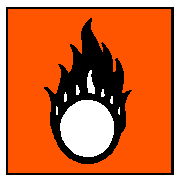International Chemical Safety Cards
| CHROMIUM (VI) OXIDE | ICSC: 1194 |
| CHROMIUM (VI) OXIDE Chromic trioxide Chromic acid Chromic anhydride CrO3 Molecular mass: 100.01 CAS # 1333-82-0 RTECS # GB6650000 ICSC # 1194 UN # 1463 (anhydrous) EC # 024-001-00-0 |
 |
 |
| TYPES OF HAZARD/ EXPOSURE |
ACUTE HAZARDS/ SYMPTOMS |
PREVENTION | FIRST AID/ FIRE FIGHTING |
| FIRE | Not combustible but
enhances combustion of other substances. Many reactions may cause fire or explosion. |
NO contact with combustible
substances and reducing agents. |
Powder, water spray, foam,
carbon dioxide. |
| EXPLOSION | |
|
In case of fire: keep
drums, etc., cool by spraying with water. |
| EXPOSURE | |
PREVENT DISPERSION OF DUST!
AVOID ALL CONTACT! |
IN ALL CASES CONSULT A
DOCTOR! |
| INHALATION | Cough. Laboured breathing.
Shortness of breath. Sore throat. Wheezing. |
Avoid inhalation of fine
dust and mist. Ventilation (not if powder), local exhaust, or breathing protection. |
Fresh air, rest.
Half-upright position. Artificial respiration if indicated. Refer for medical attention. |
| SKIN | Redness. Skin burns. Pain.
|
Protective gloves.
Protective clothing. |
Remove contaminated
clothes. Rinse skin with plenty of water or shower. |
| EYES | Redness. Pain. Permanent
loss of vision. Severe deep burns. |
Safety spectacles, face
shield, or eye protection in combination with breathing protection. |
First rinse with plenty of
water for several minutes (remove contact lenses if easily possible), then take to a
doctor. |
| INGESTION | Abdominal cramps. |
Do not eat, drink, or smoke
during work. Wash hands before eating. |
Rinse mouth. Do NOT induce
vomiting. Give plenty of water to drink. Refer for medical attention. |
| SPILLAGE DISPOSAL | STORAGE | PACKAGING & LABELLING | ||
| Do NOT wash away into sewer.
Sweep spilled substance into containers; if appropriate, moisten first to prevent dusting.
Carefully collect remainder, then remove to safe place. Do NOT absorb in saw-dust or other
combustible absorbents (extra personal protection: complete protective clothing including
self-contained breathing apparatus). |
Separated from combustible
and reducing substances, food and feedstuffs, bases. Dry. |
Do not transport with food
and feedstuffs. O symbol T symbol R: 49-8-25-35-43 S: 53-45 Note: E UN Hazard Class: 5.1 UN Subsidiary Risks: 8 UN Packing Group: II |
||
| SEE IMPORTANT INFORMATION ON BACK | ||||
|
||||